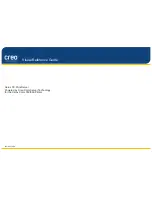
Chapter 11: Board Configuration
MAXCS ACC 6.7 Administration Manual 123
Reading the Statistics
The
Statistics
panel displays the number of errors that have occurred since the last
system reboot or statistics clearing. There may be non-zero values when configuring the
T1 span for the first time. You can clear these fields with the
Clear
button.
L1 failure: <No Sync
Frames
Layer 1 failure, physical
layer; no valid framing is
detected.
Possible span mis-configuration
(ESF is selected but the actual
framing is SF, or vice versa).
Check span configuration.
L1 failure: <Red
Alarm>
Layer 1 failure, physical
layer; Bi-Polar Violations
(BPV), Line Code Violations
(LCV), or Out Of Frame
detected
Location condition, equipment
problem.
- For excessive BPV/LCV, check
AMI/B8ZS setting.
- For OOF, check the MVIP bus
master setting.
OR
Have CO perform a line test to
check for a faulty cable or line.
[PRI only]
L2 Failure: <No Sync
Flag>
Layer 2 failure, data link
layer; no sync flag has
been detected in data link
layer
Check if D-channel is active or
not
[PRI only]
L2 Failure: <Not
established>
Layer 2 failure, data link
layer; the peer-to-peer link
has not established in data
link layer
CO must activate HDLC link
Error
Meaning
Frame Errors
Number of framing bit errors. In T1 mode, a framing bit
error is defined as an incorrect FS-bit value. The counter is
suppressed when framer loses frame alignment
OOF Errors
The Out Of Frame counter registers every time the T1 chip
is forced to re-frame when receiving a frame with severe
errors.
Rec Frame Slips
The Receiver Frame Slips counter shows the number of
frame slips for the receiver.
Line Code Errors
Line Code Error is defined as an occurrence of a bi-polar
variation or excessive zeroes.
Bit Errors
Bit Errors are defined as a CRC-6 error in ESF, FT-bit
error in SLC-96 and F-bit or sync bit error in SF.
Xmt Frame Slips
Transmit Frame Slips counter shows the number of
frame slips for the transmitter
Clear
button
Use the
Clear
button to reset the statistics counters.
Error Message
Meaning
Action
Summary of Contents for ACC 6.7
Page 16: ...2 MAXCS ACC 6 7 Administration Manual ...
Page 44: ...Chapter 2 System Requirements and Installation 30 MAXCS ACC 6 7 Administration Manual ...
Page 56: ...Chapter 3 Getting Around MaxAdministrator 42 MAXCS ACC 6 7 Administration Manual ...
Page 98: ...Chapter 6 Voice Mail Configuration 84 MAXCS ACC 6 7 Administration Manual ...
Page 108: ...Chapter 7 Auto Attendant Configuration 94 MAXCS ACC 6 7 Administration Manual ...
Page 124: ...Chapter 9 Call Recording Configuration 110 MAXCS ACC 6 7 Administration Manual ...
Page 128: ...Chapter 10 Application Extension Configuration 114 MAXCS ACC 6 7 Administration Manual ...
Page 180: ...Chapter 12 Trunk Configuration 166 MAXCS ACC 6 7 Administration Manual ...
Page 186: ...Chapter 13 In Call Routing Configuration 172 MAXCS ACC 6 7 Administration Manual ...
Page 234: ...Chapter 16 Setting Up IP Extensions 220 MAXCS ACC 6 7 Administration Manual ...
Page 246: ...Chapter 17 AltiGen IP Phone Configuration 232 MAXCS ACC 6 7 Administration Manual ...
Page 256: ...Chapter 18 Mobile Extension Configuration 242 MAXCS ACC 6 7 Administration Manual ...
Page 270: ...Chapter 19 Hunt Group Configuration 256 MAXCS ACC 6 7 Administration Manual ...
Page 274: ...Chapter 20 Paging Group Configuration 260 MAXCS ACC 6 7 Administration Manual ...
Page 370: ...Chapter 26 Redundancy Configuration 356 MAXCS ACC 6 7 Administration Manual ...
Page 404: ...Chapter 29 TAPI Integration 390 MAXCS ACC 6 7 Administration Manual ...
Page 426: ...Chapter 30 Tools and Applications 412 MAXCS ACC 6 7 Administration Manual ...
Page 448: ...434 MAXCS ACC 6 7 Administration Manual ...














































